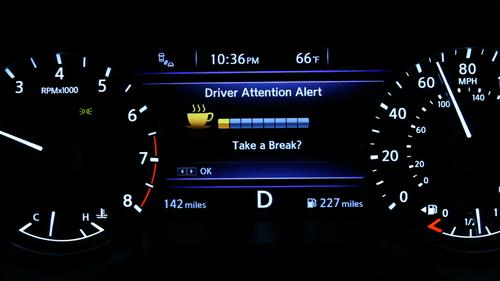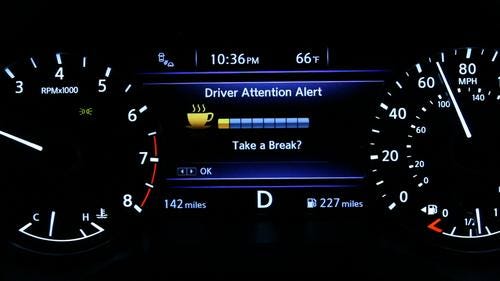Nissan's Position Sensor Provides Wake-Up Call 23117
April 16, 2015

Using a steering angle sensor instead of a camera, Nissan Motor Co. engineers have introduced a simpler way to monitor driver drowsiness.
Known as Driver Attention Alert, the new system studies steering angle sensor inputs over the first 15 minutes of driving, establishes a pattern, and then uses a microcontroller to help look for exceptions to it. If it detects erratic behavior, or actions that might suggest sleepiness, it lights up a coffee cup icon on the instrument panel and sounds an alarm. The system is an alternative to the camera-based methods that monitor a driver's eyes.
"We preferred this to facial recognition because it's easier to track from a consistency standpoint," Nissan spokesman Josh Clifton told Design News. "Human behavior can be inconsistent, especially when you're looking at how many times someone's eyes blink or how they sit."

Drowsy driving has become a growing concern for automakers and industry regulators alike. According to a recent AAA survey, it accounts for about 300,000 crashes a year. About 6,400 of those are fatal, representing a stunning percentage of about one-fifth of the US total.
At least nine auto companies now employ driver drowsiness systems, typically in mid- to high-end vehicle lines. Most use optical sensing in combination with complex software algorithms to watch the behavior of the driver or action of the vehicle. Toyota's Driver Monitoring System, for example, employs a charge-coupled device (CCD) camera mounted on the steering column to track the driver's eyes. Ford Motor's Driver Alert, meanwhile, uses a front-facing camera to examine the car's movement on the roadway.
MORE FROM DESIGN NEWS: Wake-Up Call for Inattentive Drivers
Nissan's system is a departure in that it uses a position sensor and an MCU to statistically analyze human behavior. The design is predicated on the idea that drowsy drivers tend to suddenly overcorrect for small mistakes -- in other words, they jerk the steering wheel in a characteristic fashion when they feel themselves nodding off. Up to now, only Mercedes-Benz, with its Attention Assist, has used a similar technique.
Nissan has installed Driver Attention Alert on two production vehicles -- the 2015 Murano crossover and the upcoming 2016 Maxima sedan. The automaker will study the technology on those vehicles in hopes of expanding the feature across its portfolio, possibly even in entry-level vehicles. "There's no reason you couldn't spread this across the entire vehicle line," Clifton told us. "As we do redesigns, we may very well add it to other vehicles."
Senior technical editor Chuck Murray has been writing about technology for 31 years. He joined Design News in 1987, and has covered electronics, automation, fluid power, and autos.
Design engineers, New England's premier design and manufacturing event, Design & Manufacturing New England, will take place in Boston, May 6-7, 2015. A Design News event, Design & Manufacturing New England is your chance to meet qualified suppliers, get hands-on with the latest technologies, be informed, and expand your network. Learn more here.
About the Author(s)
You May Also Like

.jpg?width=300&auto=webp&quality=80&disable=upscale)

